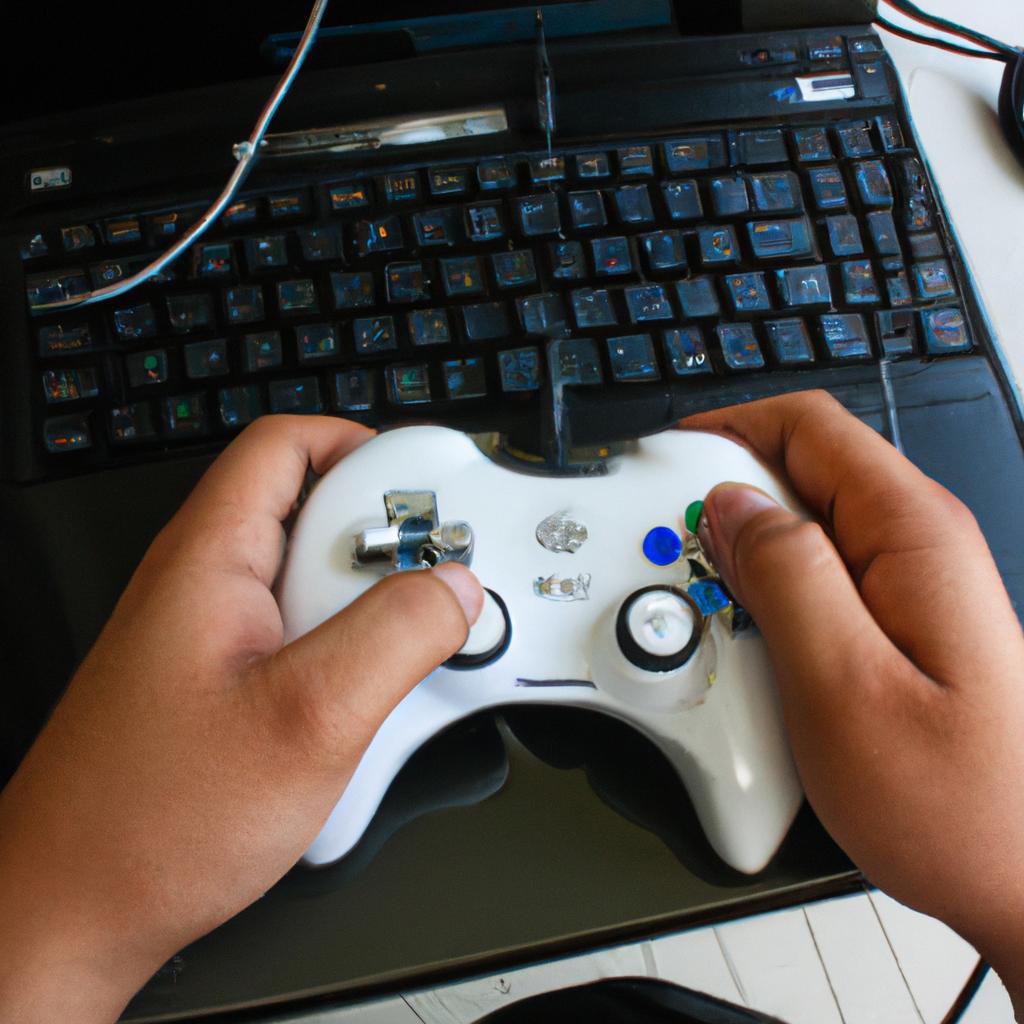The rise of online gaming has led to the increasing popularity of game streaming platforms, where players can broadcast their gameplay live over the internet. However, one crucial aspect that determines the success or failure of an online game streaming session is stream quality and performance. The ability to deliver a seamless, high-quality stream is essential for both broadcasters and viewers alike. Imagine being a viewer eagerly watching your favorite gamer’s livestream only to experience constant buffering, lagging, and pixelated visuals that disrupt your viewing experience. Such issues not only frustrate viewers but also hinder the growth and reach of streamers. In this article, we will delve into the secrets behind achieving optimal stream quality and performance in online game streaming.
Ensuring smooth and uninterrupted streams requires addressing various technical factors that impact stream quality. One crucial factor lies in having a stable internet connection with sufficient bandwidth capacity to handle the data transfer demands during live streaming sessions. For instance, if a broadcaster attempts to stream graphically intensive games without a robust internet connection, it may lead to dropped frames, delayed audio transmission, and overall poor video quality. Additionally, considerations such as hardware specifications (e.g., CPU power and GPU capabilities), software settings optimization, encoding techniques selection (such as x264 or NVENC), and network optimization also play a significant role in delivering high-quality streams.
To ensure smooth streaming, streamers should invest in reliable internet service providers (ISPs) that offer high upload speeds, as streaming requires a stable and consistent connection. It is advisable to opt for a wired Ethernet connection instead of relying on Wi-Fi, as it provides more stability and avoids potential interference issues.
Hardware specifications are crucial for stream quality. A powerful CPU can handle the encoding process efficiently, while a capable GPU assists with rendering graphics smoothly. Streamers may need to upgrade their hardware if they experience performance issues during streaming.
Software settings optimization involves configuring broadcasting software such as OBS (Open Broadcaster Software) or XSplit to achieve optimal stream quality. Adjusting settings like bitrate, resolution, frame rate, and video codec ensures efficient data transfer without sacrificing visual fidelity. Experimenting with different settings and consulting online resources can help find the ideal configuration for each individual’s setup.
Choosing the appropriate video encoding technique is essential. Popular options include x264 software encoding and NVENC hardware encoding (available on NVIDIA GPUs). Each has its advantages and disadvantages in terms of resource utilization and image quality. Streamers must consider their system capabilities and desired output quality when selecting an encoding method.
Network optimization involves minimizing latency and packet loss by prioritizing network traffic dedicated to streaming applications. This can be achieved through Quality of Service (QoS) settings on routers or using dedicated network equipment designed for gaming or live streaming purposes.
In conclusion, achieving optimal stream quality and performance in online game streaming requires addressing technical factors such as stable internet connections, suitable hardware specifications, software settings optimization, choice of video encoding technique, and network optimization. By investing time and effort into these aspects, streamers can provide viewers with a seamless viewing experience while growing their own audience base in this competitive space.
Understanding Stream Quality
When it comes to online game streaming, stream quality plays a crucial role in determining the overall user experience. Imagine you are an avid gamer eagerly waiting for the release of a highly anticipated multiplayer game. You have prepared your gaming setup, invited friends to join you, and finally launch the game only to be greeted by laggy gameplay and pixelated graphics. Frustrating, isn’t it? This example highlights the importance of understanding stream quality and its impact on online gaming.
To comprehend stream quality better, let’s explore some key aspects that contribute to a high-quality streaming experience:
- Resolution: The resolution refers to the number of pixels displayed on-screen. Higher resolutions such as 1080p or even 4K provide more detail and clarity, enhancing visual immersion during gameplay.
- Frame Rate: Frame rate determines how smoothly the visuals appear on screen. A higher frame rate, commonly measured in frames per second (FPS), results in smoother motion and reduces input delay, allowing gamers to react quickly in fast-paced games.
- Bitrate: Bitrate refers to the amount of data transmitted per unit of time during streaming. It affects both video and audio quality. Higher bitrates ensure sharper image details and clearer sound reproduction but require faster internet speeds for smooth playback.
- Compression: Streaming platforms often compress video content to reduce file sizes for efficient delivery over networks. However, excessive compression can lead to artifacts like blocky images or blurry textures, compromising visual fidelity.
To grasp these concepts visually, consider the following table showcasing different combinations of resolution, frame rate, bitrate, and compression levels with corresponding descriptions:
| Resolution | Frame Rate | Bitrate | Compression Level |
|---|---|---|---|
| 720p | 30 FPS | Low | High |
| 1080p | 60 FPS | Medium | Moderate |
| 4K | 120 FPS | High | Low |
As we delve further into optimizing network connections, it becomes evident that understanding stream quality is fundamental in achieving an enjoyable online gaming experience. By comprehending the impact of resolution, frame rate, bitrate, and compression on streaming performance, gamers can make informed decisions to enhance their gameplay visuals and reduce latency. So let’s explore how to optimize our network connection for seamless online game streaming.
(Note: Transition sentence) Moving forward, we will discuss the steps required to optimize your network connection for a smooth online gaming experience without compromising stream quality.
Optimizing Network Connection
Now that we have delved into the importance of stream quality, let us turn our attention to optimizing network connections. Imagine you are an avid gamer, eagerly awaiting the release of a highly anticipated online multiplayer game. You spend hours preparing your gaming setup – ensuring your computer is up-to-date and ready for action. However, when the time comes to play, you encounter frustrating lag and poor stream quality. This scenario highlights the critical role that network connection optimization plays in delivering a seamless streaming experience.
To optimize your network connection for online game streaming, consider following these key steps:
- Prioritize wired connections: While it may be convenient to connect wirelessly, using a wired Ethernet connection can significantly improve stability and reduce latency issues.
- Upgrade your internet plan: Check if your current internet plan provides sufficient bandwidth for smooth streaming. Higher download and upload speeds will contribute to better stream quality.
- Manage background applications: Close unnecessary applications running in the background as they consume valuable bandwidth resources and processing power.
- Consider Quality of Service (QoS) settings: Enable QoS on your router to prioritize gaming traffic over other activities, such as file downloads or video streaming.
The table below illustrates the impact of different networking setups on stream quality based on potential scenarios:
| Networking Setup | Stream Quality |
|---|---|
| Wired Connection + High-Speed Internet | Excellent |
| Wireless Connection + Moderate-Speed Internet | Good |
| Wireless Connection + Low-Speed Internet | Fair |
| Unstable Connection (e.g., frequent disconnections) | Poor |
By investing effort into improving your network connection through these steps, you can ensure smoother gameplay with minimal interruptions.
In our quest for optimal performance during online game streaming, understanding stream quality and optimizing network connections go hand in hand. Once you have established a stable and reliable connection, it is time to move on to selecting suitable hardware components that will further enhance your gaming experience. So, let us now explore the world of choosing the right hardware to complement our optimized network connection setup.
Choosing the Right Hardware
Transitioning from the previous section on optimizing network connection, let us now delve into another crucial aspect of ensuring a seamless online game streaming experience – choosing the right hardware. To illustrate this point, let’s consider an example where a gamer with a high-speed internet connection experiences frequent lag and buffering issues while live streaming their gameplay to viewers.
In order to address such challenges, it is important for streamers to take certain factors into consideration when selecting their hardware setup:
- Processor (CPU): A powerful CPU is essential for handling the demanding tasks involved in both gaming and streaming simultaneously. It ensures smooth gameplay performance without compromising on stream quality.
- Graphics Card (GPU): The GPU plays a significant role in rendering high-quality graphics during gameplay. By investing in a capable GPU, streamers can maintain visual excellence throughout their streams.
- Memory (RAM): Sufficient RAM capacity is necessary for multitasking between various applications while streaming games. With ample memory at hand, streamers can avoid system slowdowns that may affect both gameplay and stream stability.
- Storage: Fast storage options like solid-state drives (SSDs) allow games and other software to load quickly, reducing potential delays caused by data retrieval processes.
| Hardware Component | Impact on Streaming Performance |
|---|---|
| Processor (CPU) | Determines processing power available for encoding the live stream |
| Graphics Card (GPU) | Influences video quality and enhances graphical effects during gameplay |
| Memory (RAM) | Ensures efficient multitasking capabilities during gaming/streaming sessions |
| Storage | Reduces loading times and minimizes interruptions due to slow data access |
By carefully considering these aspects when choosing their hardware setup, gamers can optimize their network connection even further and minimize any potential disruptions or latency issues that may arise during streaming sessions.
Transitioning into the subsequent section on configuring streaming software, streamers can take their optimized hardware and explore how to tailor their software settings for an enhanced live streaming experience.
Configuring Streaming Software
When it comes to online game streaming, achieving optimal stream quality and performance is crucial for a truly immersive experience. In this section, we will explore the process of fine-tuning your setup to ensure smooth gameplay and high-quality streams. To illustrate the importance of these considerations, let’s consider a hypothetical case study:
Imagine you are an avid gamer who has recently started streaming on popular platforms like Twitch or YouTube Gaming. You have invested in powerful hardware, including a high-end gaming PC and a reliable internet connection. However, despite having all the necessary tools at your disposal, you notice occasional lag spikes and lower-than-desired video quality during your streams.
To address such issues, here are some key factors to keep in mind:
1. Bitrate selection: Adjusting the bitrate settings can significantly affect the overall stream quality. Higher bitrates generally result in better image clarity but require more bandwidth. On the other hand, lower bitrates may reduce visual fidelity but can help prevent buffering issues for viewers with slower internet connections.
2. Encoder settings: The choice of encoder software plays a vital role in optimizing stream performance. Popular encoding options include x264 (CPU-based) and NVENC (GPU-based). Experimenting with different encoder settings can help find the right balance between video quality and system resource utilization.
3. Resolution and frame rate: While higher resolutions and frame rates offer visually stunning results, they also demand more processing power from both your computer and viewers’ devices. Carefully selecting appropriate resolution and frame rate based on your target audience’s preferences and device capabilities can enhance their viewing experience without sacrificing performance.
- Frustration when encountering frequent lag spikes during intense gaming moments.
- Disappointment due to blurry visuals that hinder immersion in virtual worlds.
- Satisfaction derived from providing viewers with a smooth and visually appealing streaming experience.
- Excitement when receiving positive feedback from the community about stream quality.
To further illustrate these considerations, here is an example of a table showcasing different resolution options along with their corresponding frame rates and perceived video quality:
| Resolution | Frame Rate (fps) | Video Quality |
|---|---|---|
| 720p | 30 | Standard |
| 1080p | 60 | High |
| 1440p | 120 | Ultra |
By carefully calibrating your setup based on these factors, you can enhance both your gaming experience and the satisfaction of your audience.
Managing Bandwidth Usage
Transitioning from the previous section, where we discussed configuring streaming software, let’s now delve into another crucial aspect of online game streaming – optimizing stream quality. To illustrate the importance of this topic, consider a hypothetical scenario in which a popular Twitch streamer noticed a significant decline in viewer engagement due to frequent buffering issues and low video quality during their live streams.
To enhance your viewers’ experience and attract a larger audience, here are some key strategies for optimizing stream quality:
-
Select an appropriate bitrate: The bitrate determines the amount of data transmitted per second during a live stream. Choosing the right bitrate is essential as it directly impacts both video and audio quality. Higher bitrates result in better clarity but require more bandwidth. Conversely, lower bitrates may reduce visual fidelity but can help prevent buffering issues for viewers with slower internet connections.
-
Optimize encoding settings: Efficiently encoding your stream can significantly impact its overall performance and quality. Experiment with different encoding presets and adjust parameters like resolution, framerate, and compression levels to strike a balance between visual appeal and resource usage.
-
Ensure hardware compatibility: Streaming demanding games while maintaining high-quality output requires capable hardware components such as powerful CPUs or GPUs. Check system requirements for your chosen streaming software and ensure that your computer meets or exceeds them to avoid potential bottlenecks or dropped frames during gameplay.
-
Monitor network stability: A stable internet connection plays a vital role in delivering smooth streams without interruptions. Use tools like speed tests to evaluate your network’s upload capacity and check for any irregularities that might hinder optimal streaming performance.
Now let us examine how these optimization techniques intertwine with effectively managing bandwidth usage by referring to Table 1 below:
| Optimization Technique | Benefits |
|---|---|
| Selecting an appropriate bitrate | Ensures smoother playback on all devices |
| Optimizing encoding settings | Balances visual quality and resource consumption |
| Ensuring hardware compatibility | Prevents performance issues during streaming |
| Monitoring network stability | Maintains a stable connection for uninterrupted streams |
By implementing these strategies, you can significantly enhance the quality of your live game streaming sessions, garnering greater viewer engagement and satisfaction.
Moving forward, we will explore another critical aspect of online game streaming – minimizing latency and lag. By addressing these issues, you can create a seamless experience for both yourself as the streamer and your viewers alike.
Minimizing Latency and Lag
Imagine you’re in the middle of an intense online gaming session. You’ve managed your bandwidth usage effectively, but suddenly, you start experiencing frustrating lag and latency issues that hinder your gameplay. To ensure a smooth streaming experience with minimal interruptions, it is crucial to minimize latency and lag. By understanding the factors contributing to these issues and implementing effective strategies, gamers can optimize their stream quality and enhance their overall gaming experience.
To address the issue of minimizing latency and lag, one effective strategy is optimizing network settings. Ensuring that your router firmware is up-to-date and using wired connections instead of relying solely on Wi-Fi can significantly reduce latency. Additionally, prioritizing game traffic by configuring Quality of Service (QoS) settings on your router allows for better allocation of bandwidth resources during gameplay.
Another factor to consider when aiming for optimal stream performance is choosing the right encoding settings. Video encoders such as x264 or NVENC offer different trade-offs between video quality and system resource consumption. Experimenting with various encoder configurations based on hardware capabilities can help strike a balance between visual fidelity and smooth streaming performance.
Finally, utilizing adaptive bitrate streaming technology plays a vital role in avoiding buffering issues caused by fluctuations in internet speeds. This technique automatically adjusts the video quality according to available bandwidth, ensuring a seamless viewing experience even under less than ideal network conditions.
Emotional bullet point list:
- Frustration mounts when frequent lag interrupts immersive gameplay.
- Inadequate network optimization hampers the overall gaming experience.
- Buffering-induced disruptions lead to loss of engagement.
- Suboptimal encoding settings compromise both visual quality and smoothness.
Table – Advantages & Disadvantages of Different Encoders:
| Encoder Type | Advantages | Disadvantages |
|---|---|---|
| x264 | Excellent image quality | High CPU usage |
| NVENC | Low impact on CPU | Lower image quality |
| Quick Sync | Balanced performance | Limited compatibility |
By implementing these strategies, gamers can optimize their stream quality and minimize latency and lag issues during online gameplay. Remember that a smooth streaming experience not only enhances immersion but also ensures fair competition in multiplayer games. With proper network optimization, encoder configuration, and adaptive bitrate streaming technology, players can fully enjoy the thrill of online gaming without interruptions.
 FSC Clan
FSC Clan



